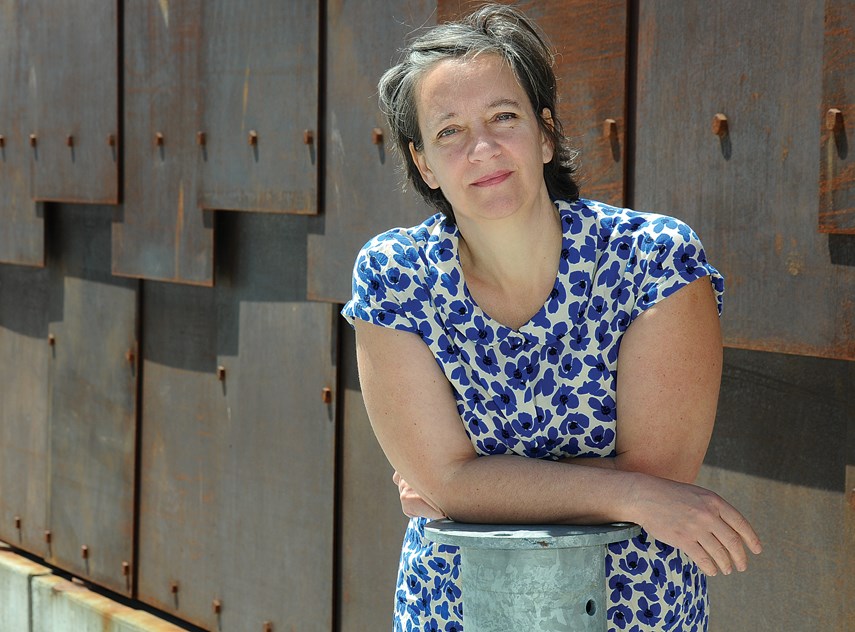Faith Moosang: Bitter Air, an immersive site-specific, 1940s radio drama, at 125 Victory Ship Way, North Vancouver. Download app for iOS devices at: apple.co/2K6hVnW.
“Hey, you! Hey!”
A gruff male voice cuts through the air like a welder’s torch through metal.
“What’s going on, Charles?” a woman asks.
“Trying to get his attention,” he responds.
“Whose attention?”
“The man on the mast!”
“The mast? Well that’s George Holt,” the woman replies. “I saw him go up a half hour ago.”
The man pays her no mind and continues to yell after character who has scaled the mast of a ship.
“Hey you! Are you all right? Can you come down?”
“You think this is a problem?” the woman persists. “George has been up the mast tons of times. He’s not one to freeze up.”
“Lots of men have,” the man says grimly. “Won’t be the first time … or the last.”
The terse exchange – and formidable foreshadowing – takes place along the North Shore waterfront 75 years ago, where thousands of workers, men and women, would have filled the now-gone Burrard Dry Dock to build fleets of ships during the Second World War.
The scene is just one of 14 played out by 12 different actors as part of Bitter Air, a radio drama written, researched and cast by multimedia artist, curator, writer and researcher Faith Moosang.
The piece is one of four projects commissioned by Polygon Gallery for its new digital program: The Polygon Outside. The program animates sites along the North Shore’s waterfront and Spirit Trail locations, using photographs, videos texts and audio material – featured on a downloadable app.
“What this app does is it starts on Oct. 30, 1943, which is called Devil’s Night,” says Moosang. “It begins in a highly dramatic moment, on the shore, or on the dry dock here, and then . . . something happens.”
You’ll have to head down to the site to satisfy your curiosity, she says wryly.
In fact, the installation cleverly turns technology on its ear, requiring the audience to actively participate for their cultural gratification, rather than simply sitting on the couch, thumb-scrolling, phone in hand.
In Bitter Air, as visitors physically move through the space at 125 Victory Ship Way, the app springs into life, and they are suddenly amidst the workers and the chaos of the Burrard Dry Dock, including the situation that unfolds around the man on the mast.
Each of the separate scenes are connected in a coherent storyline. When one scene ends, the following one does not begin until the participant walks on to the next location.
And the time investment needed is far more substantial than the standard three-minute YouTube video, with Bitter Air clocking in at an hour and 20 minutes – much like a feature-length film, Moosang notes.
The piece explores the socio/economic/political history of the shipyard, delving into union history, women in the industrial workforce and family.
“There’s strong language, tough situations, fights,” Moosang says, noting it’s creative non-fiction rooted in facts.
Meticulously researched at the North Vancouver Museum and Archives over many months, the piece is gritty and shockingly real, she says. What stuck with Moosang was the level of trauma experienced by the people of the day, the severity of injuries suffered on the job and the generally tough conditions.
“A lot of people got really injured here and a lot of death,” Moosang says. “There was a lot of… stuff happening all through this place. And that’s the whole point of my app in a way, is to sort of bring these people into the forefront a bit more, to say that this is not all lost, that this happened here.”
On site, Moosang says she feels a little like the ghosts of the people are all around her, a feeling that is not all that unwelcome, she confesses.
“I’m very attracted to marginal spaces… derelict spaces,” she says, confiding that she used to sneak into the dry dock during the 1990s when she was completing her photography degree at Emily Carr College of Art and Design (now a university).
“I’m a romantic,” she says. “I have a proclivity for things that are a little bit sad.”
Along with Moosang’s piece, three other projects are featured in the program, which runs until June 2019:
T’uy’t’tanat-Cease Wyss: Cultural Crossings
A site-specific, digital research project
Welch Street & Mathias Road, West Vancouver.
Bruce Stewart: Dollarton Pleasure Faire, 1972
Photographs from the infamous Maplewood Mudflats
2645 Dollarton Highway, North Vancouver.
Lowry’s Cabin
A site-specific, 360-degree virtual recreation of author Malcolm Lowry’s cabin
Cates Park
4141 Dollarton Highway, North Vancouver.



